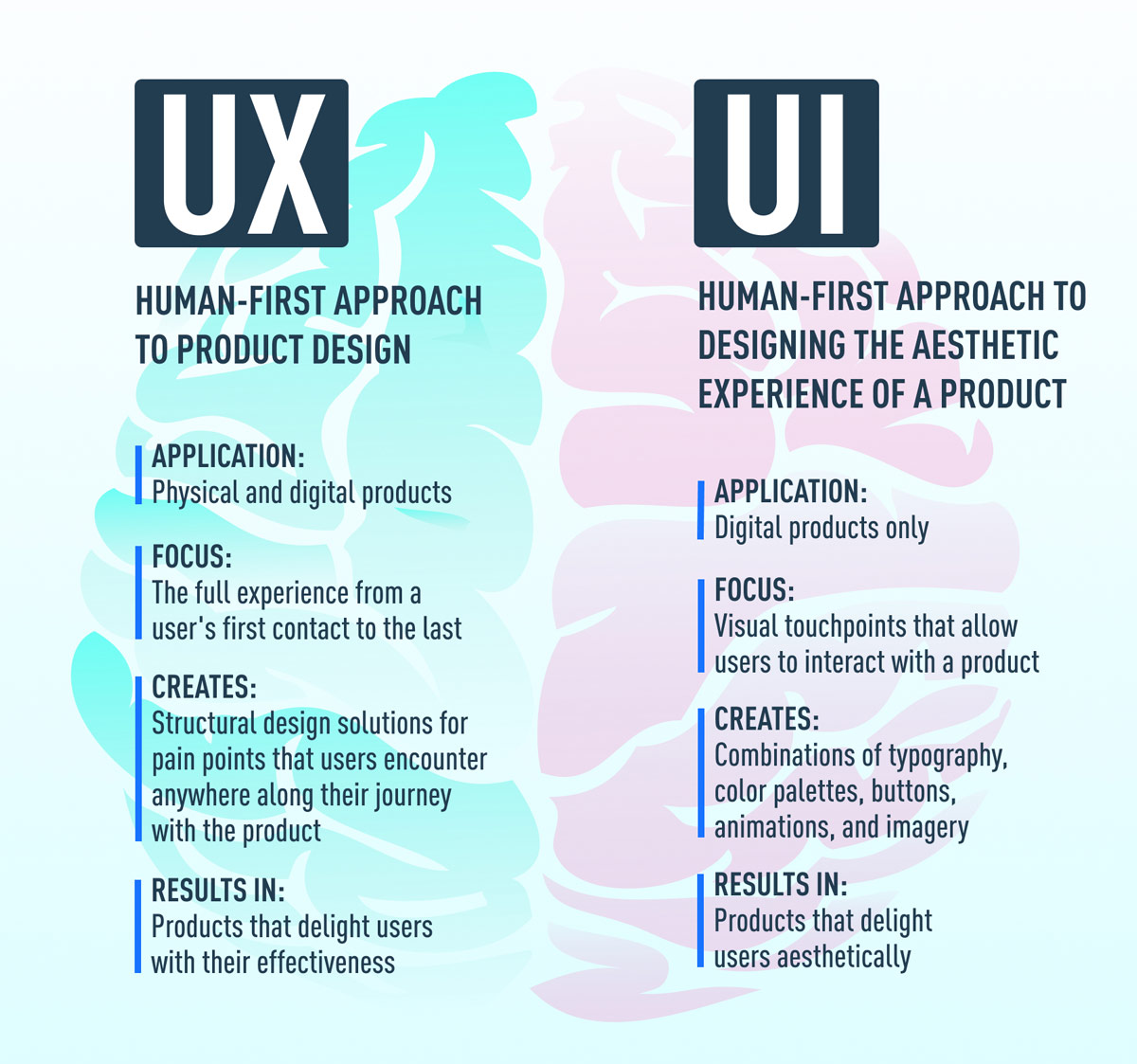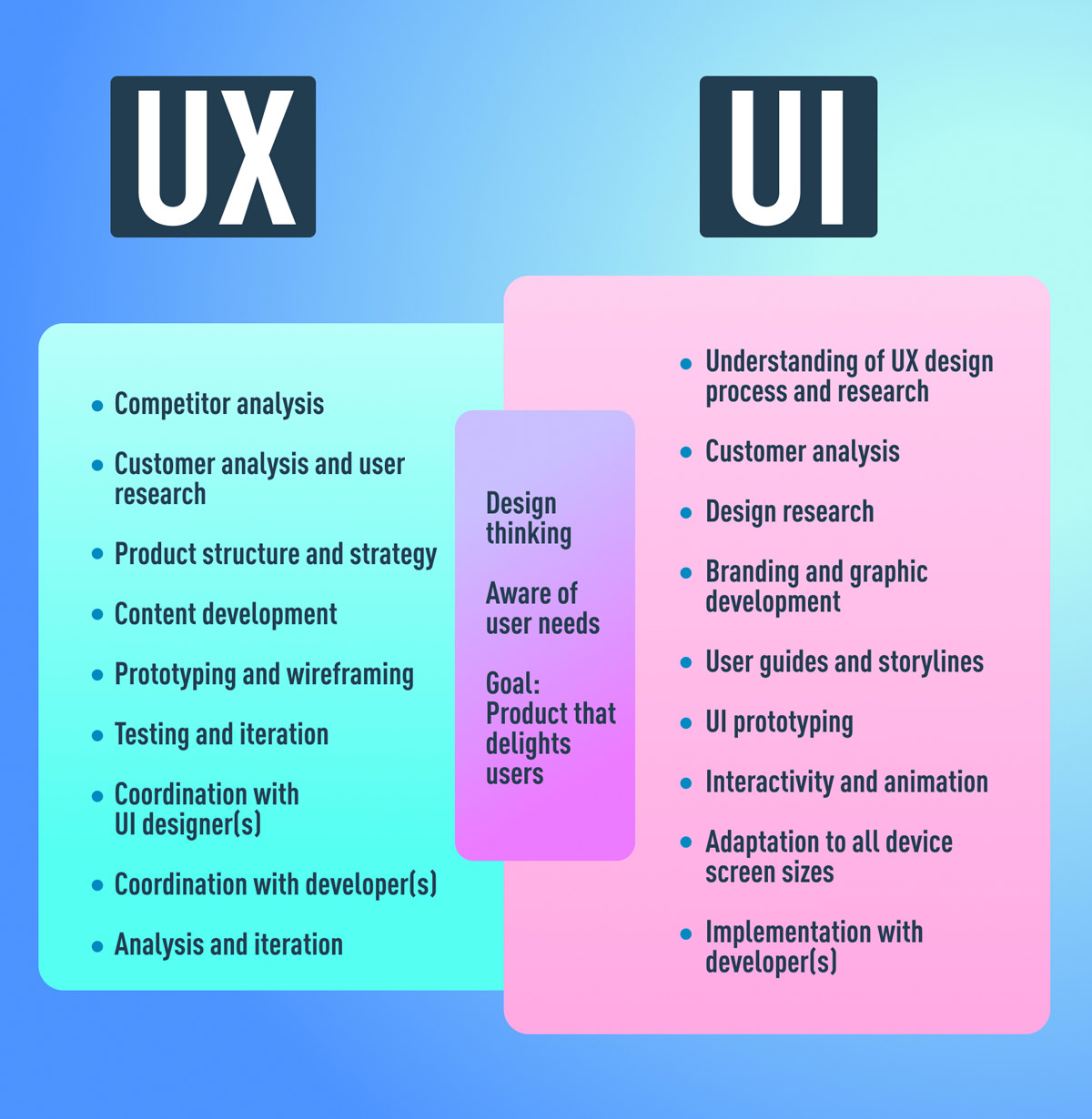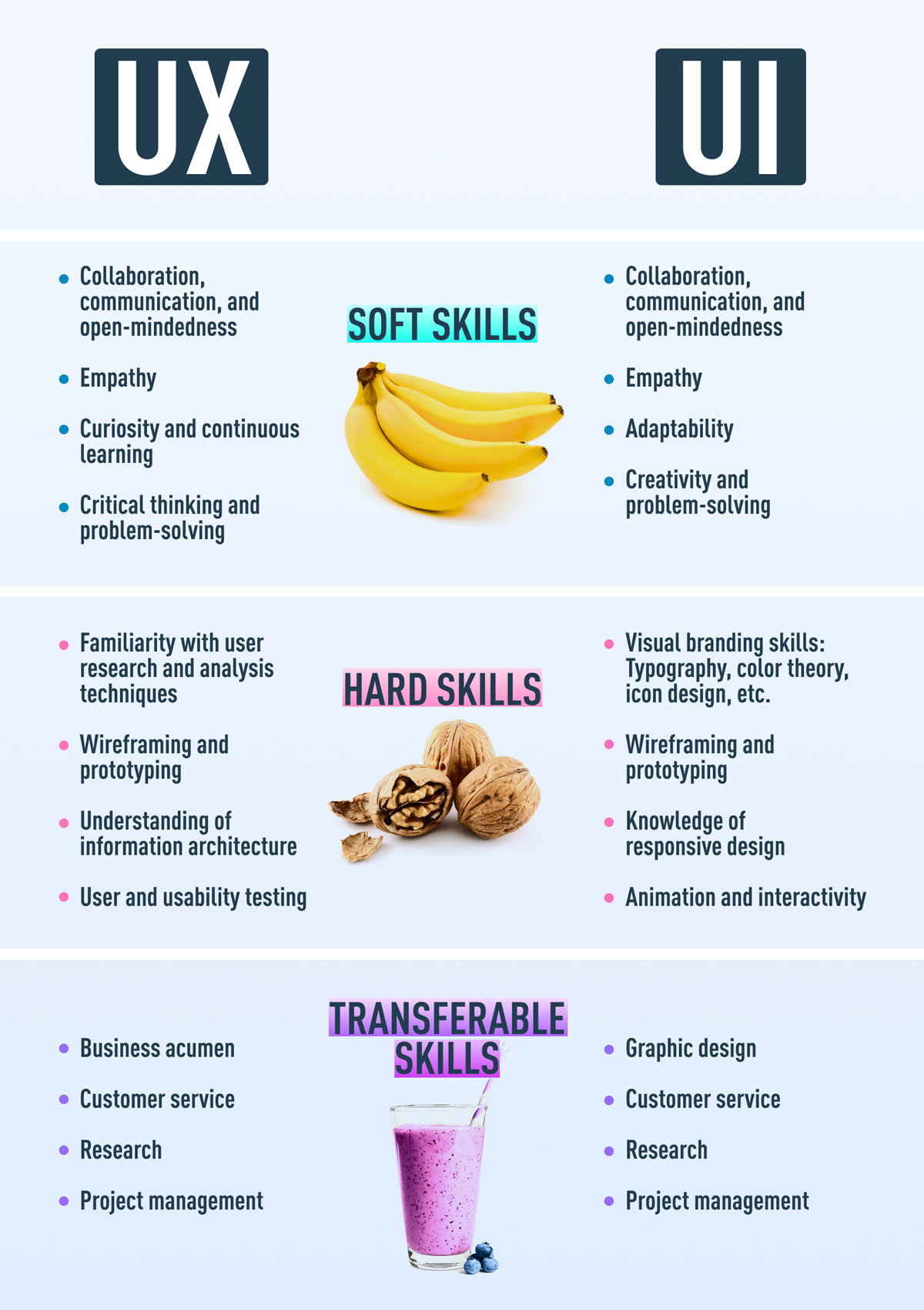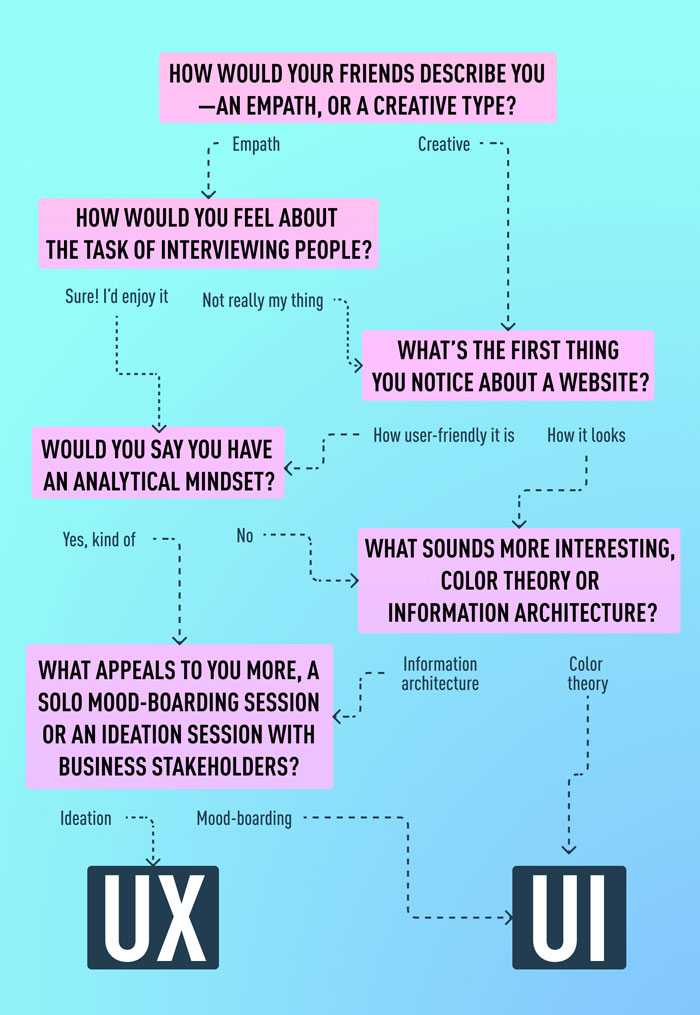Discover the key differences between UX and UI design—and figure out which is the better career path for you.
If you’re wondering about the difference between UX and UI design, you’re not alone. They’re often used interchangeably, but they actually describe very different things.
UX vs. UI in a nutshell:
- UX design (or user experience design) focuses on how intuitive, easy, and enjoyable it is to use a product (like a website or an app). It involves conducting research to understand user needs, and mapping out a logical structure and flow for the product.
- UI design (or user interface design) focuses on the visual, interactive elements of the product. It designs all the screens and components that the user interacts with. It’s about creating digital products that are both aesthetically pleasing and flawlessly functional.
Keep reading to learn more about the differences between UX and UI, how they work together, and their respective tasks, responsibilities, salaries, and more.
- UX vs. UI design
- Understanding the key differences between UX and UI design
- How do UX and UI design work together?
- Should you become a UX designer or a UI designer?
- Key takeaways
- UX vs. UI FAQs
1. UX vs. UI design
UX design stands for “user experience design,” while UI stands for “user interface design.”
They both relate to how products are created (think: websites, apps, and software). However, they focus on different aspects of the product.
UX design maps out the end user’s overall experience, or journey, throughout the product. It considers things like:
- What end-user problem should this product solve?
- What features and functions does the user need within the product?
- How should the product be structured and mapped out? How can we make it as logical and intuitive as possible?
- How will different content and information be organized throughout the product?
- How does the user feel while interacting with the product? What’s the overall quality of their experience?
If UX builds the product’s foundation, UI design focuses on the ‘top layer.’ UI design considers all the screens, pages, and touchpoints that people interact with while using the product. It considers things like:
- What elements does the user need on each screen or page? (Elements include things like buttons, scrollbars, images, toggles, and navigation menus).
- Where should these elements be positioned? What’s the optimal layout and visual hierarchy for each screen?
- What should happen when the user clicks on each individual element?
- How do individual screens connect and relate to each other?
- How can we make the interface visually appealing? What color schemes, imagery, and typography should we use?

We’ll dive deeper into how UX and UI differ throughout this guide. First, let’s take a closer look at what they each mean individually.
What is user experience (UX) design?
User experience design is a human-first way of designing products. Don Norman, a cognitive scientist and co-founder of the Nielsen Norman Group Design Consultancy, is credited with coining the term “user experience” in the late 1990s.
Here’s how he describes it: “User experience encompasses all aspects of the end-user’s interaction with the company, its services, and its products.”
Don Norman’s definition tells us that, regardless of its medium, UX Design encompasses any and all interactions between a potential or active customer and a company.
Note that there’s plenty of non-digital UX out there. As a scientific process, it can be applied to anything; street lamps, cars, Ikea shelving, and so on. However, despite being a scientific term, its use since its inception has been almost entirely within digital fields. One reason for this is that the tech industry started blowing up around the time of the term’s invention.
You can learn all about the fascinating history of UX design in this article.
Essentially, UX applies to anything that can be experienced—be it a website, a coffee machine, or a visit to the supermarket. The “user experience” part refers to the interaction between the user and a product or service. User experience design, then, considers all the different elements that shape this experience.
Read more about the term in our complete guide to UX design.
What does UX design involve?
A UX designer thinks about how the experience makes the user feel and how easy it is for the user to accomplish their desired tasks. They also observe and conduct task analyses to see how users actually complete tasks in a user flow.
For example: How easy is the checkout process when shopping online? How easy is it for you to grip that vegetable peeler? Does your online banking app make it easy for you to manage your money?
The ultimate purpose of UX design is to create easy, efficient, relevant, and all-around pleasant experiences for the user.
Here’s what you need to know about UX design in a nutshell:
- User experience design is the process of developing and improving the quality of interaction between a user and all facets of a company.
- User experience design is, in theory, a non-digital (cognitive science) practice but used and defined predominantly by digital industries.
- UX design is NOT about visuals; it focuses on the overall feel of the experience.
What does a UX designer do? Tasks and responsibilities
We know, in abstract terms, what the role of the UX designer entails—but how does this translate into everyday tasks? Here is an example of a UX designer’s typical tasks and responsibilities.
You’ll find a more detailed account of the UX design process in this guide.
Strategy and content:
- Competitor analysis
- Customer analysis and user research
- Product structure and strategy
- Content development
Wireframing and prototyping:
- Wireframing
- Prototyping
- Testing and iteration
- Development planning
Execution and analytics:
- Coordination with UI designers
- Coordination with developers
- Tracking goals and integration
- UX analysis and iteration
So part marketer, part designer, part project manager: the UX role is complex, challenging, and multi-faceted.
In fact, the role of the UX designer varies hugely depending on the type of company they’re working in. You see that iteration of the product, as connected to analysis or testing, is indeed mentioned twice, but in reality, you would put it in between every other item on the list.
Ultimately, the aim is to connect business goals to users’ needs through a process of user and usability testing and refinement toward that which satisfies both sides of the relationship.
What is user interface (UI) design?
Despite it being an older and more practiced field, the question “What is user interface design?” is difficult to answer because of its broad variety of misinterpretations.
While user experience is a conglomeration of tasks focused on the optimization of a product for effective and enjoyable use, user interface design is its complement; the look and feel, the presentation and interactivity of a product.
But like UX, it is easily and often confused by the industries that employ UI designers—to the extent that different job posts will often refer to the profession as completely different things.
Unlike UX, user interface design is a strictly digital term.
A user interface is the point of interaction between the user and a digital device or product—like the touchscreen on your smartphone or the touchpad you use to select what kind of coffee you want from the coffee machine.
In relation to websites and apps, UI design considers the look, feel, and interactivity of the product. It’s all about making sure that the user interface of a product is as intuitive as possible, and that means carefully considering each and every visual, interactive element the user might encounter.
A UI designer will think about icons and buttons, typography and color schemes, spacing, imagery, and responsive design.
Read more about the role in our complete guide to UI design.
What does UI design involve?
Like user experience design, user interface design is a multi-faceted and challenging role. It is responsible for the transference of a product’s development, research, content, and layout into an attractive, guiding, and responsive experience for users.
To summarize what UI design is all about:
- User interface design is a purely digital practice. It considers all the visual, interactive elements of a product interface—including buttons, icons, spacing, typography, color schemes, and responsive design.
- The goal of UI design is to visually guide the user through a product’s interface. It’s all about creating an intuitive experience that doesn’t require the user to think too much!
- UI design transfers the brand’s strengths and visual assets to a product’s interface, making sure the design is consistent, coherent, and aesthetically pleasing.
What does a UI designer do? Tasks and responsibilities
If you like the idea of creating awesome user experiences but see yourself as a more visual person, you may be more interested in UI design. You’ll find a brief snapshot of the UI designer’s key tasks below, or a more comprehensive explanation of what a UI designer actually does in this guide.
The look and feel of the product:
- Customer analysis
- Design research
- Branding and graphic development
- User guides and storylines
Responsiveness and interactivity:
- UI prototyping
- Interactivity and animation
- Adaptation to all device screen sizes (responsive / adaptive design)
- Implementation with developer
As a visual and interactive designer, the UI role is crucial to any digital interface and, for customers, a key element to trusting a brand. While the brand itself is never solely the responsibility of the UI designer, its translation to the product is.
You’ll also note the final point, which states responsibility for the “implementation” of the design with a developer. While this is generally how UI jobs have worked in the past, you should be aware that the lines are blurring, as the term “web designer” (essentially a UI designer who can code) is being replaced by the expertise of user interface designers.
While UX has no need for coding, UI is a role that, as time progresses, will rely on it as part of building interactive interfaces, with “UI developer” beginning to appear as a role in companies.
We’ve created a full guide to UI development for you to check out.
Now we have a clear-cut definition of both UX and UI, let’s consider the key differences between the two.
2. Understanding the key differences between UX and UI design

As Rahul Varshney, co-creator of Foster.fm puts it:
“User Experience (UX) and User Interface (UI) are some of the most confused and misused terms in our field. A UI without UX is like a painter slapping paint onto a canvas without thought; while UX without UI is like the frame of a sculpture with no paper mache on it. A great product experience starts with UX followed by UI. Both are essential for the product’s success.”
It’s important to understand that UX and UI do go hand-in-hand; you can’t have one without the other. However, you don’t need to possess UI design skills to be a UX designer, and vice versa—UX and UI constitute separate roles with separate processes and tasks!
The main difference to bear in mind is this: UX design is all about the overall feel of the experience, while UI design is all about how the product’s interfaces look and function.
A UX designer considers the user’s entire journey to solve a particular problem; what steps do they take? What tasks do they need to complete? How straightforward is the experience?
Much of their work focuses on finding out what kinds of problems and pain points users come up against and how a certain product might solve them. They’ll conduct extensive user research in order to find out who the target users are and what their needs are in relation to a certain product.
Learn more: A Guide to Data-Driven Design
They’ll then map out the user’s journey across a product, considering things like information architecture—i.e., how the content is organized and labeled across a product—and what kinds of features the user might need. Eventually, they’ll create wireframes that set out the bare-bones blueprints for the product.
With the skeleton of the product mapped out, the UI designer steps in to bring it to life. The UI designer considers all the visual aspects of the user’s journey, including all the individual screens and touchpoints that the user might encounter, think tapping a button, scrolling down a page or swiping through an image gallery.
While the UX designer maps out the journey, the UI designer focuses on all the details that make this journey possible. That’s not to say that UI design is all about looks; UI designers have a huge impact on whether or not a product is accessible and inclusive.
They’ll ask questions like “How can different color combinations be used to create contrast and enhance readability?” or “What color pairings cater to color blindness?” You can learn more about UI design for accessibility in our guide.
Hopefully, you’re now starting to see how UX and UI design are indeed two very different things.
UX vs. UI in summary:
- UX design is all about identifying and solving user problems; UI design is all about creating intuitive, aesthetically-pleasing, interactive interfaces.
- UX design usually comes first in the product development process, followed by UI. The UX designer maps out the bare bones of the user journey; the UI designer then fills it in with visual and interactive elements.
- UX can apply to any kind of product, service, or experience; UI is specific to digital products and experiences.

3. How do UX and UI design work together?
We’ve explored the differences between UX and UI. Now let’s take a look at how they work together.
You might be wondering if one is more important than the other, but the reality is: they’re both crucial!
Designer Helga Moreno put it rather eloquently in her article The Gap Between UX And UI Design: “Something that looks great but is difficult to use is exemplary of great UI and poor UX. While something very usable that looks terrible is exemplary of great UX and poor UI.”
UX and UI go firmly hand in hand, and while there are millions of examples of great products with one and not the other, imagine how much more successful they might have been when strong in both fields.
UI design is like the icing on the UX cake. Imagine you come up with an amazing idea for an app, something that’s clearly missing from the market and could genuinely change people’s lives for the better. You hire a UX designer to conduct user research and help you figure out exactly what features your app should have and how the entire user journey should be mapped out.
Your app offers something that your target audience needs and wants; however, when they download it, they find that the text on each screen is barely legible (think the yellow text on a white background). What’s more, the buttons are too close together; they keep hitting the wrong button by mistake! This is a classic case of bad UI destroying what would have been good UX.
On the flip side, have you ever come across a really beautiful website only to find that, beyond the mind-blowing animations and on-point color scheme, it’s actually a real pain to use? Good UI can never make up for bad UX; it’s like picking up a beautifully decorated cake that actually tastes awful when you bite into it.
So, when it comes to product design, UX and UI complement each other—and in today’s competitive market, getting both aspects right is an absolute must. Whether you choose to work as a UX designer or a UI designer, it’s useful to have an understanding of both; after all, you’ll inevitably be working together. This brings us to our next section…
Why do companies often advertise UX/UI roles as one?
We’ve established that UX and UI design are two separate fields, so now you might be wondering: why is it that so many job ads ask for UX/UI designers in one?
The truth is, in the grand scheme of things, UI/UX are still relatively new fields—and, as already mentioned, they tend to be specific to the tech industry. Outside the worlds of design and tech, they’re not so widely understood despite being incredibly important for business.
While the business value of good design is increasingly recognized, there’s still a tendency for hiring managers and recruiters to assume that UX and UI are done by the same person—hence the catch-all job ads you’ve no doubt come across.
It’s not always a simple case of misunderstanding, though. Many companies will deliberately seek out versatile designers who can cover both UX and UI or who at least have an understanding of UX or UI principles in addition to their main skillset.
So, how can you work out what’s really going on? Whether you’re looking for a UI-only role, a purely UX-focused career, or a mixture of both, it’s important to look beyond the job title and pay close attention to the skills, tasks, and responsibilities listed.
Now you know the difference between UX and UI, you should quickly be able to determine whether a job ad is actually geared towards one or the other or if it’s deliberately targeting both.
4. Should you become a UX designer or a UI designer?
While UX and UI design do go hand-in-hand, you don’t need to be a master of both.
If you want to figure out which career path is right for you, it’s important to consider the key skills required by UX vs. UI designers, as well as the typical day-to-day tasks of each.
UX vs. UI: the main skills required for each
This infographic highlights the main hard, soft, and transferable skills of both UX and UI designers.

UX vs. UI salary
Salaries in both roles are dictated by many factors, including:
- Location
- Experience
- Industry
- Company
- Project/product type
On average, you’ll find that UI and UX jobs in the U.S. have similar salary ranges across startups and tech heavyweights.
Nonetheless, it’s worth investigating companies on a case-by-case basis. Here you can see how UX and UI salaries compare in the United States, based on averages taken from Glassdoor (updated for 2025):
UX designer salaries vs. UI designer salaries:
- Junior UX Designer: $78,540; Junior UI Designer: $73,454
- UX Designer: $82,683; UI Designer: $93,981
- Senior UX Designer: $117,223; Senior UI Designer: $121,734
For greater detail, read our UX designer salary guide and UI designer salary guide.
Choosing between UX and UI
If you’re keen to pursue a career in design but still aren’t sure whether to focus on UX or UI, you’ll need to spend some time thinking about where your interests lie, as well as what you’re naturally good at.
Both UX and UI design are highly collaborative, varied career paths, placing you right at the cutting edge of technology and innovation. With that said, there are some key differences between the nature of the work and the skills required.
Why not try out this quick flowchart to get an idea of what path might be the best fit for you?

A career in UX requires empathy, a penchant for problem-solving, and an approach that is both creative and analytical. UX designers also need first-rate communication skills and a little bit of business know-how.
A career in UI also requires an understanding of user experience principles, but it’s much more focused on the visual, interactive aspects of design. If you’ve got a keen eye for aesthetics and like the idea of making technology beautiful, user-friendly, and accessible, you might be more suited to a career in UI. Of course, if you like the idea of a career that combines both UI and UX, there’s nothing to stop you from becoming a design all-rounder!
Before you make any decisions, I recommend checking out this post: Which tech career path is right for me?
Becoming a UI/UX designer
Despite their other differences, becoming a UI or UX designer requires similar approaches. Certain requirements, and ways to boost your chances at success, include:
- Developing your skills
- Having knowledge of industry tools
- Developing a portfolio
- Building your personal brand
You’ll find a detailed rundown with tips and advice in these guides:
- How to become a UX designer
- How to become a UI designer
- How Ryan became a UX designer and consultant at McKinsey
As with most things in life, education is the best, most reliable starting point.
While it is technically possible to become a UI/UX designer without any formal studying, some form of training will increase your chances of success in the field exponentially. Luckily, you’ll find an infinite range of free content and courses for both skills online.
If you’re interested in learning UX or UI design skills in order to make a career change, particularly if you’ve got little to no industry experience, you can always start with the many free UX/UI design training out there.
For those of you who are in the early stages of considering your options, we’ve put together a comprehensive guide to the best UX bootcamps, complete with recommendations of what to bear in mind when choosing a course.
5. Key takeaways
Hopefully, this post has gone some way to clearing up the long-standing confusion around UX vs. UI. What we’ve covered today is just the tip of the iceberg; there’s a lot more to both UX and UI, so it’s worth reading up on each field in depth to get a feel for what they entail and a deeper understanding of how they differ.
If you want to try out UX design or UI design for yourself, explore our free short courses:
Or chat directly with a program advisor to learn more.
Finally, if you’re keen to learn more about how to become a UI or UX designer, check out these articles:
- A day in the life of a UX designer
- How to be a better UX designer in 2025
- Which are the best UX design certification programs?
- How Ryan became a UX designer at McKinsey
6. UX vs. UI FAQs
What are the key differences between UX and UI design?
UX design focuses on the user’s overall experience, ensuring that the product meets users’ needs, goals, and expectations, and that it’s intuitive and user-friendly. UX involves conducting user research, defining information architecture, creating wireframes, and usability testing. UI design focuses on the visual, interactive properties of the product. It involves designing the layout, functionality, and visual aspects (e.g. color, icons, typography) of each screen.
Is it better to be a UX or UI designer?
Choosing between a career in UX or UI depends on your skills and interests. UX design suits those who enjoy research, problem-solving, and cross-functional collaboration. UI design is ideal for those who are creative and passionate about visual design within a digital context. Both roles are highly rewarding, and it’s possible to master both UX and UI skills to become a versatile design professional.
Who earns more, UI or UX designers?
Salaries for UX and UI designers vary based on location, experience, and company size. Generally, UX designers tend to earn slightly more due to their broader focus on user research, strategy, and problem-solving. However, skilled UI designers with expertise in creating visually appealing and interactive interfaces can command competitive salaries, especially in design-driven industries.
